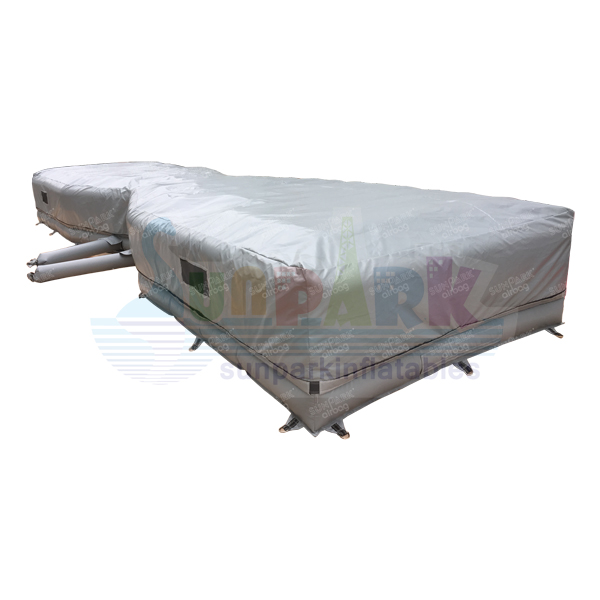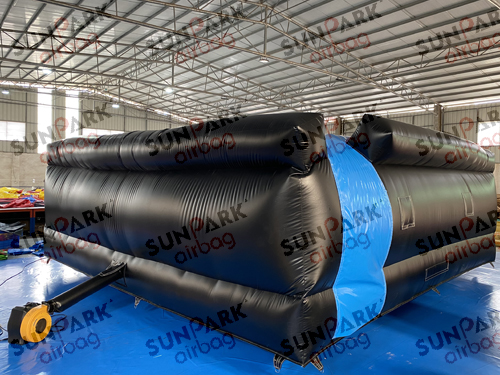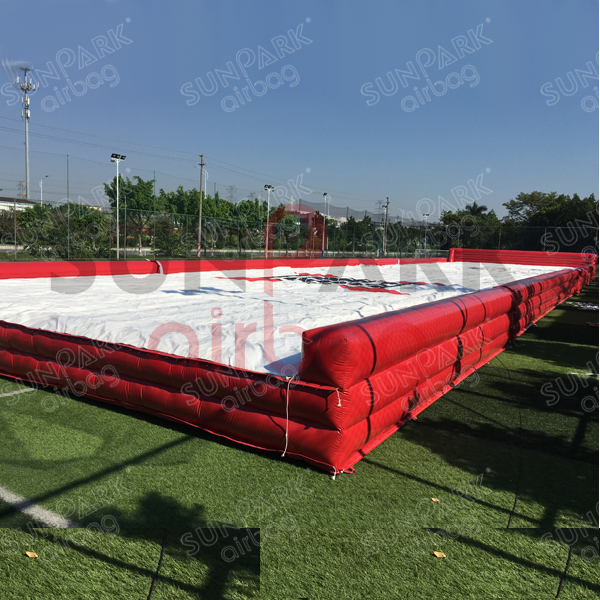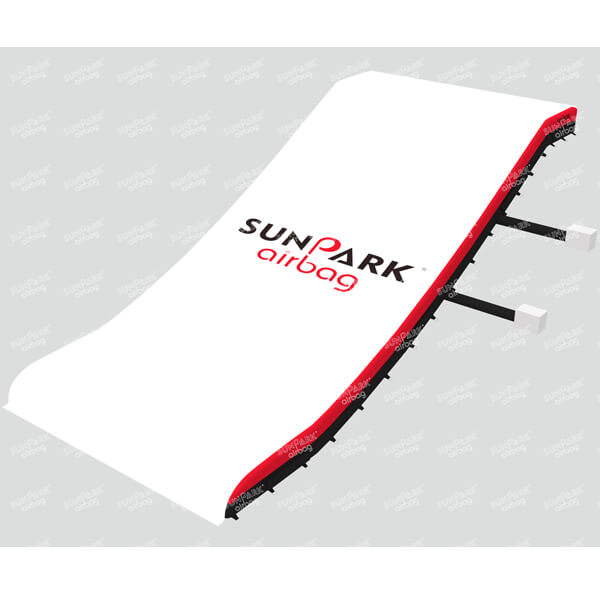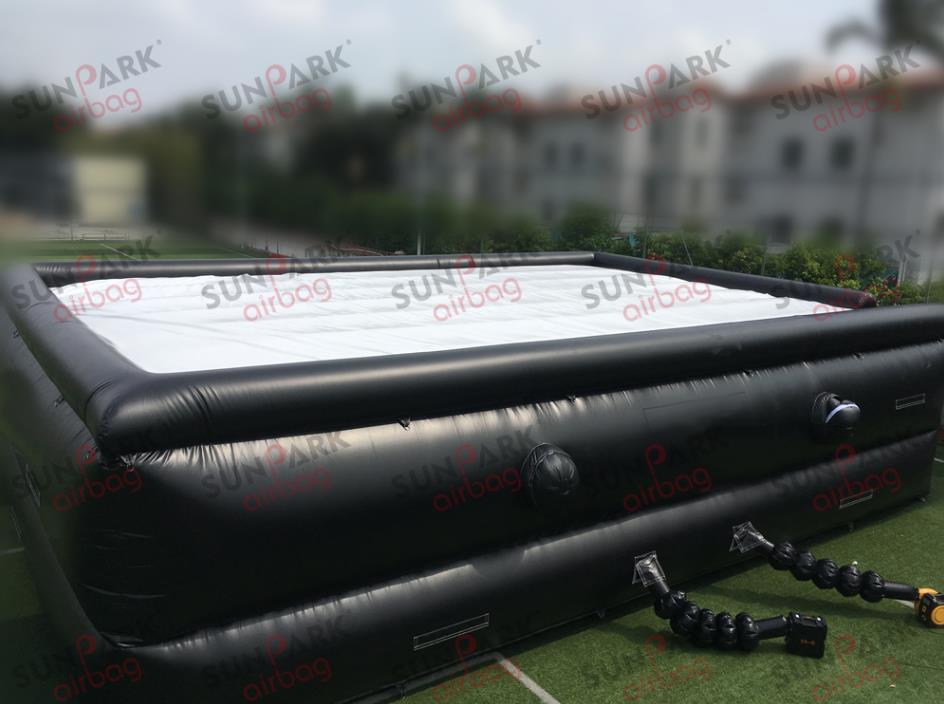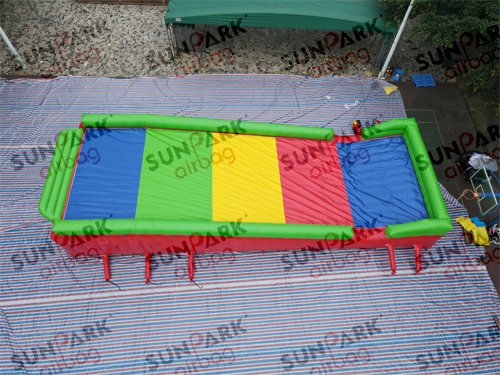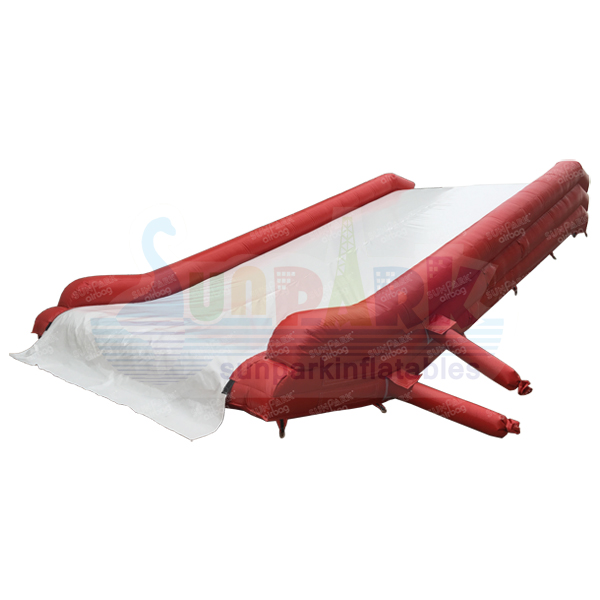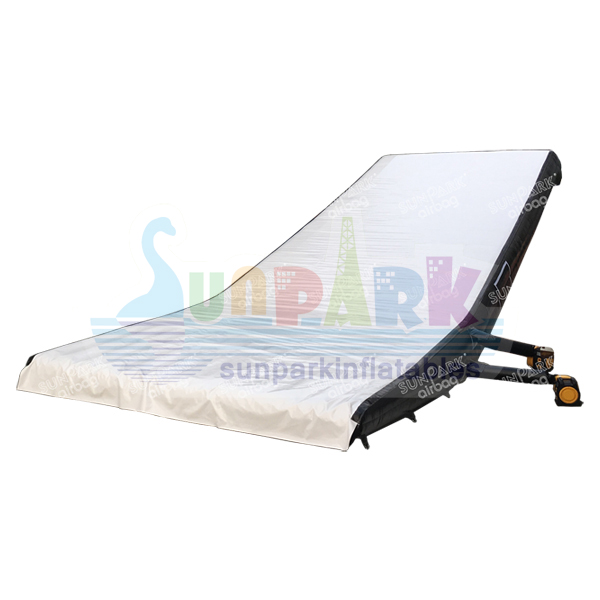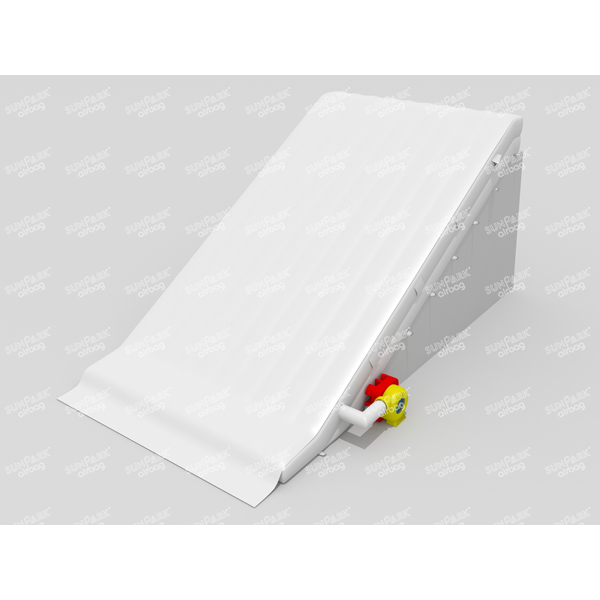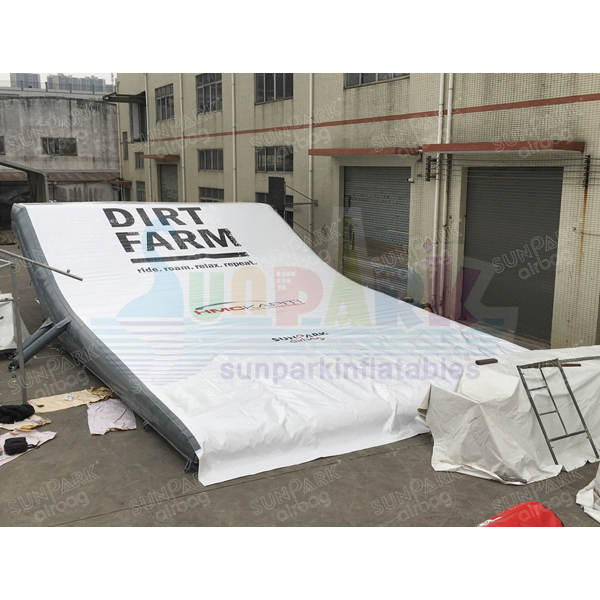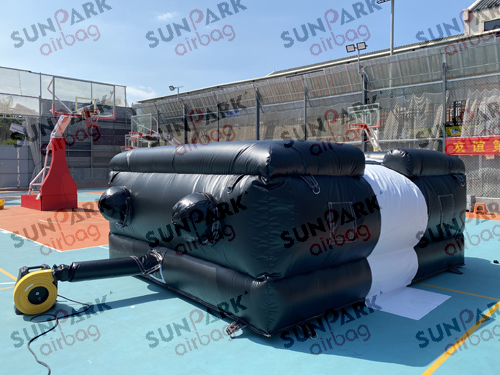Introduction — Why a landing airbag matters
A landing airbag is one of the most effective investments any park, team, event or private coach can make to speed progression and reduce injury risk. Whether you’re developing a progression program for snowboarders, training motocross riders, or running a bike skills clinic, the controlled, tunable impact surface of a modern landing airbag lets athletes attempt new movements with far less risk than hard landings or worn foam pits. In this guide we’ll walk through definitions, benefits, sizing, materials, operations, safety standards, purchasing checklists and FAQs — everything you need to choose and run a landing airbag effectively.
Short checklist: use the focus keyphrase “landing airbag” in the page title, intro, H2/H3s, and meta description to satisfy Yoast SEO; this article demonstrates that best practice.
Table of contents
What is a landing airbag?
Top benefits for athletes and operators
Landing airbag types & sport-specific use cases
Materials, construction and pressure control
How to size a landing airbag (with table)
Site prep, anchoring & operations checklist
Maintenance, inspections & lifespan
Safety standards and regulation references
Buying guide — what to ask suppliers
FAQs
Conclusion & next steps
1. What is a landing airbag?
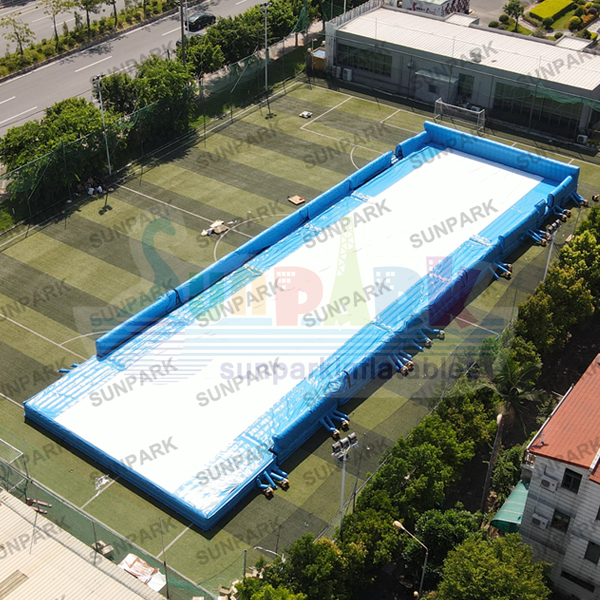
A landing airbag is an engineered inflatable cushion designed to absorb and dissipate impact energy while providing a predictable landing surface. Compared with loose foam blocks or a bare landing slope, airbags deliver:
Tunable softness (via vents/compartments)
Consistent rebound characteristics
Faster session throughput and simpler hygiene/maintenance in indoor settings
If you want to see product variations at a glance, visit SunparkAirbag’s landing collection: https://www.sunparkairbag.com/landing-airbag/.
2. Top benefits for athletes and operators
For athletes
Faster progression and confidence-building: a softer catch leads to more attempts and quicker skill acquisition.
Reduced acute injury risk from hard impacts.
Consistent landings that translate more predictably to real-world lines.
For facility operators
Improved throughput vs. traditional foam pits — quicker exit and reset.
Lower long-term maintenance for properly installed airbags.
Multi-sport versatility — one landing system can serve snowboarders, skiers, BMX, MTB, FMX and stunt performers.
Examples of multi-sport use are explained on SunparkAirbag’s main site: https://www.sunparkairbag.com.
3. Landing airbag types & sport-specific use cases
Snowboard & ski
A progression-focused ski airbag or snowboard setup typically prioritizes a mellow front edge and a forgiving catch. This encourages riders to try rotation and tweak grabs before transferring the skill to a hard-packed jump or competition rail.
Anchor (tag keyword): ski airbag
BMX & MTB
Bike landings often require abrasion-resistant topsheets and a profile that mimics dirt landings. A good MTB landing bag supports repeated wheel-to-surface impacts and reduces bottom-out risk.
Anchor (tag keywords): BMX safety — MTB landing bag
FMX & Motocross
Higher masses and speeds mean FMX airbags need reinforced construction, wider footprints and more robust anchor systems to prevent shift under heavy, repeated landings.
Stunt & Freefall
Designed for film or attractions, stunt airbags combine edge protection and fast reinflation; freefall attractions pair airbags with twin platforms for graduated experiences.
4. Materials, construction and pressure control

A pro-grade landing airbag typically includes:
Multi-chamber design (upper catch zone + safety base) for staged impact attenuation.
Independent vents so operators can tune softness for skill level and sport.
Abrasion-resistant, UV- and flame-retardant topsheets suited to outdoor and indoor conditions.
Reinforced seams and anchor points sized for wind loads and repeated use.
For product examples and construction details, review SunparkAirbag product pages: https://www.sunparkairbag.com/products/.
5. How to size a landing airbag (planning table)
Sizing depends on takeoff geometry, rider speed, and the maximum trick amplitude expected. Use the table below as a planning starting point; consult your supplier or SunparkAirbag’s technical team for a detailed site-specific design.
| Sport / Use | Typical takeoff (approx) | Recommended footprint (L × W) | Height / Cushion Depth | Notes |
|---|---|---|---|---|
| Snowboard / Ski (park) | Small–medium tables (5–12 m) | 10–15 m × 6–10 m | 1.5–2.5 m | Mellow front lip, steeper rear works for advanced riders |
| MTB / BMX (dirt jump) | Small jumps (1–3 m lips) | 8–12 m × 5–8 m | 1.5–2.2 m | Match slope angle to dirt landing grade |
| FMX practice | Larger ramps, higher speed | 12–18 m × 8–10 m | 2.0–3.0 m | Reinforced topsheet and anchoring required |
| Trampoline / gym parks | Air awareness, flips | 6–10 m × 5–8 m | 1.3–2.0 m | Foam pit airbags are also an option |
Note: These are general guidelines — always verify against measured run-in speed, jump geometry and local safety code.
6. Site preparation, anchoring & operational checklist
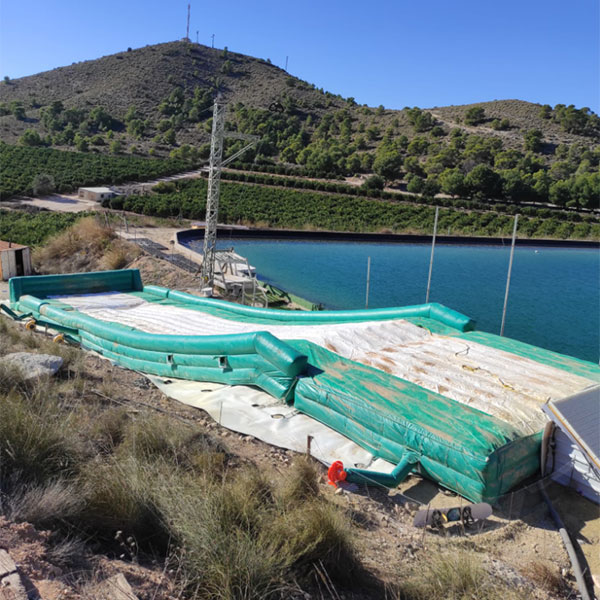
Site prep
Level, debris-free base; protective ground sheet recommended.
Run-in and run-out clearances (minimum recommended: 10–15 m depending on sport and speed).
Dedicated blower power with redundancy (UPS or backup generator recommended for public events).
Anchoring & wind considerations
Follow manufacturer anchor plans; add more anchors in windy or exposed locations.
Use edge bumpers and perimeter fencing where public access is possible.
Staffing and operations
Appoint a “lip marshal” and a “landing marshal.”
Use clear hand signals and step-by-step progression rules.
Keep a log of vent settings, weather, incidents and maintenance.
Documentation
Keep an operations manual and make a printed reference available to staff. SunparkAirbag’s product pages include installation references: https://www.sunparkairbag.com/air-landing/
7. Maintenance, inspections & expected lifespan
Daily
Visual seam checks, blower functionality, anchor integrity, and surface cleanliness.
MonthlyFull seam inspection, blower filter cleaning, test inflation and vent operation.
AnnualProfessional inspection for seams/anchors and material degradation.
Lifespan
With proper care, a well-made landing airbag can last many seasons. Material degradation is largely driven by UV, abrasion, and improper storage.
For foam-pit-style operations, consider a foam pit airbag product to minimize foam maintenance.
8. Safety standards and authoritative references
It’s critical to check applicable standards and certifications for your market and intended use. Consider these references when creating your SOPs:
ASTM guidelines relevant to inflatable impact attenuation and trampoline operations: https://www.astm.org/f2970-22.html
European playground/attraction safety (EN standards overview): https://en1176.org/
REACH materials guidance for chemical compliance in the EU: https://echa.europa.eu/regulations/reach/understanding-reach
Linking your product specifications to recognized standards helps with insurance, regulatory approval and operator confidence.
9. Buying guide — what to ask suppliers
When selecting a landing airbag, verify these items:
Chamber design & venting — Ask how many compartments and whether vents are independently adjustable.
Material specs — Request topsheet ratings for abrasion, UV, flame retardancy, and cold tolerance.
Anchor plan & wind rating — Confirm anchor points, # of anchors recommended, and wind load tolerance.
Blower spec — Voltage, redundancy options, and re-inflate time.
Service & warranty — Inquire about seam repair services, spare parts and warranty scope.
Customization — Artwork, branding and size options.
References — Ask for case studies for your intended sport (snowboard, ski, BMX, MTB, FMX, gymnastics).
SunparkAirbag’s full product list can help you match features: https://www.sunparkairbag.com/products/.
10. Frequently asked questions
Q: Can one landing airbag be used for multiple sports?
A: Yes. Most modern landing airbags are designed for multi-sport use. Adjust venting and profile to suit the current sport and athlete levels.
Q: Are airbags sanitary for indoor parks?
A: Airbag shells are easier to wipe down than foam pits; using covers or anti-slip sheets further improves hygiene.
Q: How long does it take to install?
A: Typical setup and anchoring can be completed in a few hours by trained staff; full planning depends on site prep.
Q: What’s the difference between a foam pit and a foam pit airbag?
A: Foam pits require ongoing foam replacement and cleaning. Foam pit airbags increase throughput and are easier to maintain. See product comparisons on SunparkAirbag: https://www.sunparkairbag.com/foam-pit-jump-airbag/.
11. Conclusion
A thoughtfully chosen landing airbag transforms athlete progression and facility operations. It reduces risk, increases training frequency, and broadens what your site can offer across snowboard, ski, BMX and MTB disciplines. Use this guide to plan sizing, operations and purchasing conversations — then contact your supplier (for instance, via https://www.sunparkairbag.com) to finalize an engineered solution tailored to your run-in speeds and athlete levels.

